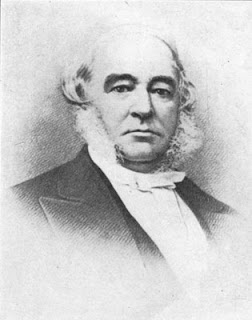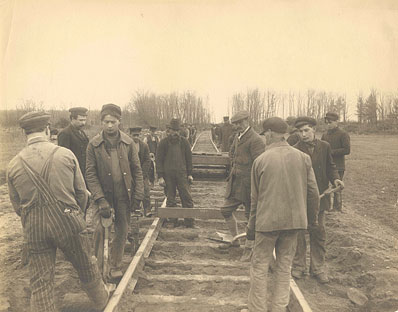Amherst College
I have just returned from a visit to Altoona, Pennsylvania, in order to see my father. While there I took a friend to see the world famous Horseshoe Curve. Many people who know my sense of humor think I am being ironical when I refer to it that way, but those who are railroad buffs know better. When it first opened, the Curve was acclaimed as one of the eight wonders of the modern world, along with such sights as the Eiffel Tower and London’s Crystal Palace. But few know of it now, and therein is a sad story.
The Horseshoe Curve came into existence in 1854, as the solution to a seemingly unsolvable engineering problem – how to build a railroad that could cross the high point of the Allegheny Mountains in order to connect Philadelphia and Pittsburgh. There was an urgent need to solving the problem. New York especially was becoming the major trade route between east and west, due to the success of the Erie Canal.
At the time, the most efficient route between Pittsburgh and Philadelphia was the Portage Canal and Rail, a combination of boat – through the Susquehanna and Juniata Rivers to the town of Hollidaysburg, where the boats would be hoisted onto cars, which then would be pulled by rope up a series of steep inclined planes to the top of the mountain ridge. A trip between Philadelphia and Pittsburgh took six to seven days, when the weather was favorable. And the transport of freight was just about out of the equation all together, due to the expense.
To address this problem, in 1846 the Commonwealth of Pennsylvania chartered the Pennsylvania Railroad and hired the engineers John Edgar Thomson and Herman Haupt to take charge of its construction. They decided that the most efficient route through the mountains was to follow old Indian trails along the ridges of the mountains, straight through the center of the state. This route was perfect, except for one barrier – Kittanning Gap, a spot that interrupted the path between two major ridges. To build a bridge of over two thousand feet to connect the ridges would have been impossible at the time, mainly because the degree of incline would have been close to 3%, much too steep for a locomotive to manage.
I have just returned from a visit to Altoona, Pennsylvania, in order to see my father. While there I took a friend to see the world famous Horseshoe Curve. Many people who know my sense of humor think I am being ironical when I refer to it that way, but those who are railroad buffs know better. When it first opened, the Curve was acclaimed as one of the eight wonders of the modern world, along with such sights as the Eiffel Tower and London’s Crystal Palace. But few know of it now, and therein is a sad story.
The Horseshoe Curve came into existence in 1854, as the solution to a seemingly unsolvable engineering problem – how to build a railroad that could cross the high point of the Allegheny Mountains in order to connect Philadelphia and Pittsburgh. There was an urgent need to solving the problem. New York especially was becoming the major trade route between east and west, due to the success of the Erie Canal.
At the time, the most efficient route between Pittsburgh and Philadelphia was the Portage Canal and Rail, a combination of boat – through the Susquehanna and Juniata Rivers to the town of Hollidaysburg, where the boats would be hoisted onto cars, which then would be pulled by rope up a series of steep inclined planes to the top of the mountain ridge. A trip between Philadelphia and Pittsburgh took six to seven days, when the weather was favorable. And the transport of freight was just about out of the equation all together, due to the expense.
To address this problem, in 1846 the Commonwealth of Pennsylvania chartered the Pennsylvania Railroad and hired the engineers John Edgar Thomson and Herman Haupt to take charge of its construction. They decided that the most efficient route through the mountains was to follow old Indian trails along the ridges of the mountains, straight through the center of the state. This route was perfect, except for one barrier – Kittanning Gap, a spot that interrupted the path between two major ridges. To build a bridge of over two thousand feet to connect the ridges would have been impossible at the time, mainly because the degree of incline would have been close to 3%, much too steep for a locomotive to manage.
So what did they do? They imported about 400 Irish laborers, who, with only black powder, picks, chisels and wheelbarrows, created a landfill. The landfill contained more cubic footage than all of the Great Pyramids of Egypt combined, and created a ridge where there had been a valley. Around that ridge the railroad was laid, in the shape of horseshoe, at an incline of about 1.3%. The time of travel between Philadelphia and Pittsburgh was cut to less than a day, and freight was able to make it through the mountains. The Pennsylvania Railroad became, for a time, the largest railroad, by almost every measure – 10,000 miles of track, three times the freight and revenue of its closest competitors – through the first half of the 20th century, and at one point was the world’s largest publically traded corporation. Indeed, for some years its revenue stream was larger than that of the U.S. government, and it still holds the record for continuous dividend payments to its shareholders, over a 100 years. At its peak, the PRR employed over 250,000 workers.
The Horseshoe Curve was such a critical national link in the transportation system that Nazi Germany targeted it for sabotage during World War II. But what the Nazis couldn’t destroy, GM and Dwight Eisenhower could. The establishment of the Interstate Highway System in 1956, pushed by Eisenhower, established a national Highway Trust Fund to build and maintain what is now the dominant form of transport in the country. Railroads immediately went into decline, though the PRR continued to be profitable, until forced by the Interstate Commerce Commission, as part of its 1968 merger with the ailing New York Central Railroad, to take on several other highly unprofitable lines. Two years later, after the U.S. government, led by Eisenhower’s former vice-president, and strapped for money because the Vietnam War, reneged on a $200 million loan guarantee, and the newly named Penn Central Railroad went bankrupt. The pieces went to first to Conrail, a court created successor to the Penn Central, and then to Northern Southern Railway, and CSX, none of which carry passengers.
I drove on the Interstate to visit Dad, and on the return trip to Amherst our car was hit by a truck. The car was totaled. Lucky for me, the airbags deployed. But I had plenty of time while waiting at the car rental in Wappinger Falls, New York, and then on the remainder of the long trip, to think about what it would have meant to have a good rail system in place. Instead of the grinding drive, a relaxing journey. Instead of the crazy drivers, wasted fuel, and butt ugly scenery, perhaps a glass of wine, a meal, and time to read. Instead of wreckage on the highway . . . well, you get the point.
One of the most interesting aspects of this story, it seems to me, is the overt and clear participation of government in the building and maintenance of transportation systems. The assumption, even for the building of the Interstate Highway, that there is a necessary role for the state to play in such huge projects that have such serious impact on the lives of the citizenry, is a shibboleth to the ideologues now in charge of Congress. John Mica (R) from Florida, currently chair of the House Transportation and Infrastructure Committee, has called for drastic cuts in the next round of Highway Trust Fund spending, ignoring the fact that those funds are supposed to be dedicated to transportation projects.
The Horseshoe Curve was such a critical national link in the transportation system that Nazi Germany targeted it for sabotage during World War II. But what the Nazis couldn’t destroy, GM and Dwight Eisenhower could. The establishment of the Interstate Highway System in 1956, pushed by Eisenhower, established a national Highway Trust Fund to build and maintain what is now the dominant form of transport in the country. Railroads immediately went into decline, though the PRR continued to be profitable, until forced by the Interstate Commerce Commission, as part of its 1968 merger with the ailing New York Central Railroad, to take on several other highly unprofitable lines. Two years later, after the U.S. government, led by Eisenhower’s former vice-president, and strapped for money because the Vietnam War, reneged on a $200 million loan guarantee, and the newly named Penn Central Railroad went bankrupt. The pieces went to first to Conrail, a court created successor to the Penn Central, and then to Northern Southern Railway, and CSX, none of which carry passengers.
I drove on the Interstate to visit Dad, and on the return trip to Amherst our car was hit by a truck. The car was totaled. Lucky for me, the airbags deployed. But I had plenty of time while waiting at the car rental in Wappinger Falls, New York, and then on the remainder of the long trip, to think about what it would have meant to have a good rail system in place. Instead of the grinding drive, a relaxing journey. Instead of the crazy drivers, wasted fuel, and butt ugly scenery, perhaps a glass of wine, a meal, and time to read. Instead of wreckage on the highway . . . well, you get the point.
One of the most interesting aspects of this story, it seems to me, is the overt and clear participation of government in the building and maintenance of transportation systems. The assumption, even for the building of the Interstate Highway, that there is a necessary role for the state to play in such huge projects that have such serious impact on the lives of the citizenry, is a shibboleth to the ideologues now in charge of Congress. John Mica (R) from Florida, currently chair of the House Transportation and Infrastructure Committee, has called for drastic cuts in the next round of Highway Trust Fund spending, ignoring the fact that those funds are supposed to be dedicated to transportation projects.
Compounding the misery of our trip on the highway, on our drive home we listened to Mica pontificating on C-SPAN radio, explaining how Amtrak is an abject failure and waste of money, how we can be much more efficient if we would privatize highways, with no evidence, but with a lot of conviction in his voice. When listeners called in suggesting that perhaps running two wars was even more inefficient, he blithely ignored them. Later, we heard how we need a balanced budget amendment to the Constitution, one that would require, when passed, 2/3 majorities in each house of Congress to pass tax increases. And so it goes.



















